26 May 2021: Clinical Research
A Study of Blended Learning Using the Smart Class Teaching Module on Psychosocial Dysfunction Course During the Training of Undergraduate Occupational Therapy Students in China
Qiang Lin1234CDEF, Yaxian Qiu123CDEF, Yanni Zhang123BCD, Yuxing Zheng123BCD, Lingzi Zhang5CD, Junjie Liang123BC, Yilifate Anniwaer13E, Yujun LiaoDOI: 10.12659/MSM.931748
Med Sci Monit 2021; 27:e931748
Abstract
BACKGROUND: Online blended learning, also known as “smart classes”, has benefits when compared with traditional teaching methods that use books and lectures. This study aimed to compare the use of the Smart Class teaching module with traditional teaching on the topic of psychosocial dysfunction during the training of undergraduate occupational therapy (OT) students in China.
MATERIAL AND METHODS: We recruited Grade 2017 OT students as the Smart Class teaching module group and Grade 2016 OT students as the Traditional Class teaching module group to participate in the study. The objective evaluation (assignment score, practical exam score, written exam score, and final score) and subjective evaluation (data from student questionnaires and information from interviews with the lead teacher and assistant teachers) were performed in both groups.
RESULTS: No significant difference was found in the final scores (P=0.874) and students’ questionnaire results between the 2 groups. However, data from the student questionnaires and teacher interviews indicated a preference for combining the Smart Class teaching module and the Traditional Class teaching module.
CONCLUSIONS: The advantage of the Smart Class teaching module is that it can effectively integrate excellent teaching resources across geographical restrictions and it is conducive to promoting independent learning for students and all-around supervision for teaching. The Smart Class teaching module was comparable to traditional teaching methods for the training of undergraduate OT students in China, but was preferred by the students.
Keywords: Educational Measurement, Occupational Therapy, Teaching, Adolescent, Curriculum, Education, Distance, Students, Medical, Surveys and Questionnaires, young adult
Background
Rehabilitation therapy started in the late 1980s in China. Medical professionals training in this field have experienced a procession from short-term training to formal academic education, yet the development is still in its infancy [1]. As an important branch of rehabilitation therapy, occupational therapy (OT) was not launched in professional direction education in Chinese universities until 2002 [2]. Only 7 universities have been accredited by the World Federation of Occupational Therapists (WFOT) for occupational therapy [3]. There is an urgent demand for occupational therapy education in line with international standards. However, there remains a gap between OT education in mainland China and international standards [4,5]. Scholars are now asking how to quickly improve OT education in mainland China [6].
The OT major in Guangzhou Medical University began in 2016 [7]. There is a lack of teaching experience in OT courses. The faculty’s composition is relatively young; there is a shortage of intermediate and senior teachers with rich teaching experience, especially in the OT courses related to psychosocial conditions. The Hong Kong Polytechnic University (PolyU) is adjacent to Guangzhou and is a cooperative unit of rehabilitation medicine education with the Guangzhou Medical University, and was ranked 75th in the QS World University Rankings in 2021 [8]. The Department of Rehabilitation Sciences of PolyU has 44 teaching staff, ranging from assistant professors to chief professors [9]. The WFOT accredited its OT program in the early 1980s. PolyU has strong faculty, rich teaching experience, and geographical proximity, which lays a solid foundation for the regional sharing of educational resources between the 2 universities. In recent years, our university has been cooperating with the Department of Rehabilitation Sciences of PolyU in course teaching. It has achieved progress in improving the quality of teaching and promoting local teachers’ training. However, the main problem in implementing the Traditional Class teaching modules is that the teachers needed to travel from Hong Kong to Guangzhou to teach undergraduate students, which was associated with intensive teaching periods throughout the weekend. As a result: (i) students had insufficient time to preview or digest the knowledge that they should master or had learned; (ii) teachers had to complete extra work for class preparation within a short time; (iii) there was a lack of interaction with students, which was not conducive to adjusting further teaching content according to the students’ feedback; and (iv) Hong Kong teachers had a lengthy commute, increasing the non-teaching costs.
Online blended learning, also referred to as “smart classes”, have benefits when compared with traditional teaching methods that use books and lectures, particularly for students who cannot access teaching centers. There have been several developments in online teaching modules, one of which is the Smart Class, an efficient and intelligent teaching and learning platform built through the Chaoxing Fanya application system (
Material and Methods
SUBJECTS:
OT students in Grade 2016 and Grade 2017 from the Fifth Affiliated College of Guangzhou Medical University were recruited to participate in the study. Inclusion criteria were: (i) age from 18 to 23 years old, (ii) a third-year undergraduate student of OT, (iii) completed the course of Occupational Therapy for Psychosocial Dysfunction, and (iv) volunteered and agreed to participate in the study.
This study was approved by the Ethics Association of the Fifth Affiliated Hospital of Guangzhou Medical University and performed in accordance with the Declaration of Helsinki. All the participants answered the questionnaire after completing the course voluntarily. The investigators presented an introductory paragraph that informed participants of the study’s aims, the confidentiality of their responses, and that they could refuse to answer any questions or withdraw from the study at any time (the details can be found in the Supplementary Material 1) [20]. All data and personal information involved in this study were collected by specific researchers and stored in locked areas, and sensitive documents were never left unattended in public locations.
INTERVENTION:
Grade 2017 OT students (the Smart Class teaching module group) completed the Smart Class teaching module. In contrast, Grade 2016 OT students (the Traditional Class teaching module group) completed the Traditional Class teaching module. Both groups took the Occupational Therapy for Psychosocial Dysfunction course, which had 42 class hours, including 18 theoretical class hours and 24 practical class hours. The lead teacher was from the Department of Rehabilitation Science, Hong Kong Polytechnic University was responsible for most of the theoretical and practical class teaching. Three young teachers from Guangzhou Medical University acted as assistant teachers, and were mainly responsible for the assistant teaching of practical classes, teaching administration arrangement, and examination work. The same course, textbook, class hours, teaching content, syllabus, and teacher team were used for the 2 groups. In the Smart Class teaching module group, the lead teacher carried out long-distance teaching from Hong Kong, while the assistant teachers assisted the teaching in Guangzhou through the Chaoxing Online Teaching Information Platform (http://i.mooc.chaoxing.com and http://gzhmu.fanya.chaoxing.com/portal). The whole teaching process was divided into: (i) Posted class requirements and studying materials before having class, and teachers observe background data to supervise students’ preview; (ii) During class, conducted activities such as discussion, questions, and answers to provide an active atmosphere in the theoretical classes, and created an online interactive space for teachers to demonstrate and supervise, for students to practice and discuss in the practical classes; (iii) Issued assignments, group discussion topics, extracurricular study resources, and other tasks after class, and teachers graded and answered questions for students to promote consolidating knowledge. The teaching time arrangement was consistent with the conventional arrangement and was carried out regularly, about 4 class hours per week. For the Traditional Class teaching group, the lead teacher traveled from Hong Kong to Guangzhou on weekends to teach face-to-face with students for 12 class hours per day. The whole course was taught over 3 weekends (6 days). The assistant teachers assisted the class teaching and administration throughout. The key elements of the Smart Class teaching module and the Traditional Class teaching module are diagrammed in Figure 1.
ASSESSMENTS:
The final course score consists of assignment, practical exam, and written exam, accounting for 10%, 20%, and 70% of the total score, respectively. The assignment and practical exam were assessed by teachers, with a full score of 100. The written exam, with a full score of 100, was designed by the teachers, which included single-answer, multiple-answer, terminology-explanation, short answer, and case analysis questions. Students from both teaching modules completed the 3 parts. The degree of difficulty for the assignments and exams was the same for the 2 groups.
STUDENT QUESTIONNAIRE:
After the Occupational Therapy for Psychosocial Dysfunction course was completed, the students under the 2 teaching modules (Smart Class teaching module and Traditional Class teaching module) were asked to complete the same online questionnaire voluntarily and anonymously (Student Questionnaire, see Supplementary Material 1 for details). The Student Questionnaire included basic student information (grade, age, and sex) and 17 multiple-choice questions about the Occupational Therapy for Psychosocial Dysfunction course, which could be grouped into 4 main topics: (i) pre-class preview (Question 4 to Question 6); (ii) in-class learning (Question 7 to Question 13); (iii) after-class review (Question 14 to Question 16); and (iv) course satisfaction (Question 17 to Question 20). The participants answered each of the 15 questions using five-point Likert-type scales [21,22], except for Question 13 and Question 19. Question 13 is a multiple-answer question to investigate what students think is an effective way to interact in class, while Question 19 is a single-answer question to survey which way students like to have class.
The Creative Research Systems survey software (
Cronbach’s alpha coefficient was greater than 0.70, indicating an acceptable level of the questionnaire’s reliability [23]. Meanwhile, the questionnaire’s validity was assessed by Kaiser-Meyer-Olkin Measure of Sampling Adequacy (KMO) and Bartlett’s sphericity test. The KMO value should be more than 0.60, and the statistically significant value should be less than 0.001 (P<0.001), which indicates that the sampling was sufficient and data had a normal distribution [24].
TEACHER INTERVIEW:
The lead teacher and assistant teachers were invited to complete a semi-structured interview after the Occupational Therapy for Psychosocial Dysfunction course had finished [25]. The interview outline focused on class preparation, teaching effect, teaching implementation, and teaching innovation. Sessions were recorded and transcribed verbatim [26]. Transcripts were read in their entirety several times to summarize the main points (interview outline and answer main points, see Supplementary Material 2 for details), examine the teaching effect, and explore teaching innovations.
STATISTICAL ANALYSIS:
Statistical analysis was carried out using IBM SPSS 25.0 software. Normally distributed data are represented by the mean±standard deviation. The median expressed measurement data that did not conform to the normal distribution and counting data are represented by constituent ratio or rate. The final scores data from 2 groups that conform to the normal distribution and the homogeneity of variance were compared using an independent samples t test. The answers A to E of 15 questions in the Student Questionnaire were assigned values of 1 to 5. The lower values indicate a worse or more negative situation versus the higher values indicating a better or more positive situation [27]. The average score was calculated within the 4 thematic categories, and then the 2 groups were statistically analyzed with a non-parametric rank-sum test [28]. P values <0.05 were considered statistically significant.
Results
BASELINE:
In this study, 40 OT students were recruited, of which 16 students of Grade 2017 participated in the Smart Class teaching module group (age, 20.75±0.68 years old; 2 male students and 14 female students), while 24 students of Grade 2016 participated in the Traditional Class teaching module group (age, 20.54±0.51 years old; 3 male students and 21 female students). There were no statistically significant differences in age (P=0.891) or gender ratio (P=0.276) between the 2 groups (Table 1).
COURSE SCORE:
No significant difference in written exam score (Smart Class teaching module: 74.00±7.15, Traditional Class teaching module: 75.88±10.39, P=0.543) or the final score (Smart Class teaching module: 77.63±5.16, Traditional Class teaching module: 78.00±8.25, P=0.874) was found when comparing the Smart Class teaching module group and Traditional Class teaching module group. However, there were statistically significant differences in assignment score (Smart Class teaching module: 86.25±2.67, Traditional Class teaching module: 83.17±4.43, P=0.017) and practical exam score (Smart Class teaching module: 86.00±1.75, Traditional Class teaching module: 82.83±5.75, P=0.040) when comparing the 2 groups (Table 2), which showed that scores of the Smart Class teaching module groups were higher than those of the Traditional Class teaching module.
STUDENT QUESTIONNAIRE:
Forty questionnaires were distributed using a free online questionnaire platform (WENJUANXING,
No statistically significant difference was found in pre-class preview, in-class learning, after-class review, or course satisfaction between the Smart Class teaching module and the Traditional Class teaching module (Table 3). However, the top 3 student responses to the in-class effective interaction methods question were the same between the 2 groups. The responses of active expression, class interaction, and group discussion were 75%, 68.5%, and 68.5%, respectively, to the Smart Class teaching module group; in comparison, for the Traditional Class teaching module, these values were 54.13%, 83.33%, and 83.33%, respectively. There were only slight differences in these proportions (Figure 2). Both groups responded to “Take theoretical classes for online teaching, 4 hours per week; take practical classes offline intensively over 2–3 weekends”, which accounts for 50% in the Smart Class teaching module and 45.83% in the Traditional Class teaching module (Figure 3).
TEACHER INTERVIEW:
The lead teacher and assistant teachers considered that both teaching modules had advantages and disadvantages. Compared with the Traditional Class teaching module, the Smart Class teaching module helps make full use of teaching resources, overcome the geographical limitations, arrange teaching schedule regularly, and promote independent learning among the students. However, the Smart Class teaching module’s implementation still relies on a smooth network and stable application platform. Moreover, it is not conducive to peer exercises for small and face-to-face interactions in the practice courses. They all suggested that the theoretical classes should be taught regularly with the Smart Class teaching module and the practical classes should be taught intensively with the Traditional Class teaching module. Meanwhile, assistant teachers believed that the application of the Smart Class teaching module should be actively promoted in the joint teaching of Guangdong, Hong Kong, and Macao, and taking full advantage of excellent teaching resources from Guangdong, Hong Kong, and Macao to improve the teaching quality of the weak local courses and the teaching skill of local young teachers.
Discussion
LIMITATIONS:
The number of our valid questionnaires was within the range of the sample size, but it is still a small size. That was due to the small class teaching for the OT students in Occupational Therapy for Psychosocial Dysfunction course. A multi-center study will be conducted in the future to increase the total number of subjects. Moreover, although there was no significant difference in gender ratio between the 2 groups in our study, there were more female students than male students in general due to the characteristics of OT major enrollment. Future research on potential factors of gender difference is needed. Also, due to the pandemic, further research for the blended teaching model combined of Smart Class teaching module and Traditional Class teaching module cannot be immediately carried out. However, we will develop the further study in the future as conditions permit.
Conclusions
The Smart Class teaching module and the Traditional Class teaching module each have advantages and disadvantages. The advantage of the Smart Class teaching module is that it can effectively integrate excellent teaching resources across geographical restrictions, and it is conducive to promoting independent learning for students and all-around supervision for teaching. It also improves the teaching quality of the weak courses and teaching skills of young teachers locally. Nevertheless, in practical courses, the Smart Class teaching module struggles to replace the advantages of the Traditional Class teaching module. Meanwhile, we suggest regularly using the Smart Class teaching module in theoretical classes, while intensively using the Traditional Class teaching module in practical classes. Our findings showed the use of the Smart Class online teaching module was comparable with traditional teaching methods for the training of undergraduate OT students in China, but was preferred by the students.
Supplementary Information
Supplementary Material 1
SUPPLEMENTARY MATERIAL 1:
INFORMED CONSENT FOR THE SUBJECT:
Dear student/subject for Occupational Therapy for Psychosocial Dysfunction study, Greetings!
This is a student questionnaire for Occupational Therapy for Psychosocial Dysfunction study in Guangzhou Medical University, which is used to understand the study situation and to help guide further teaching practice.
Our study was approved by the Ethics Association of the Fifth Affiliated Hospital of Guangzhou Medical University and is in accordance with its ethical standards. If you have any other questions, please contact the research executive Haining Ou (Tel. 86 020 82516054).
RESEARCH CONTENT AND EXPLANATION:
This Student Questionnaire includes a student’s basic information (grade, age, sex) as well as 17 multiple-choice questions about your Occupational Therapy for Psychosocial Dysfunction course.
The whole questionnaire will take you about 10 minutes to complete.
Please understand that your careful and truthful answers are essential to scientific conclusions. You do not have to guess the design of the study or the intention of the question, and there is no right or wrong answer.
CONFIDENTIALITY PRINCIPLE:
This study is not concern the subjects’ personal information, and there are no sensitive issues involved. All data in this study will be used for scientific purposes only. All data and personal information involved in this study were collected by specific researcher and stored in locked areas. Never leave sensitive documents unattended in public locations.
PARTICIPANTS’ BENEFIT:
Since this research is used for teaching reform and there is no economic benefit for anyone, no corresponding compensation is provided. Because of confidentiality, do NOT put your signature on the questionnaire. If you continue to the next page, that means you have read the above and volunteered to participate in this study. Thank you for your patience and reply.
SUPPLEMENTARY MATERIAL 2:
The
The
Figures
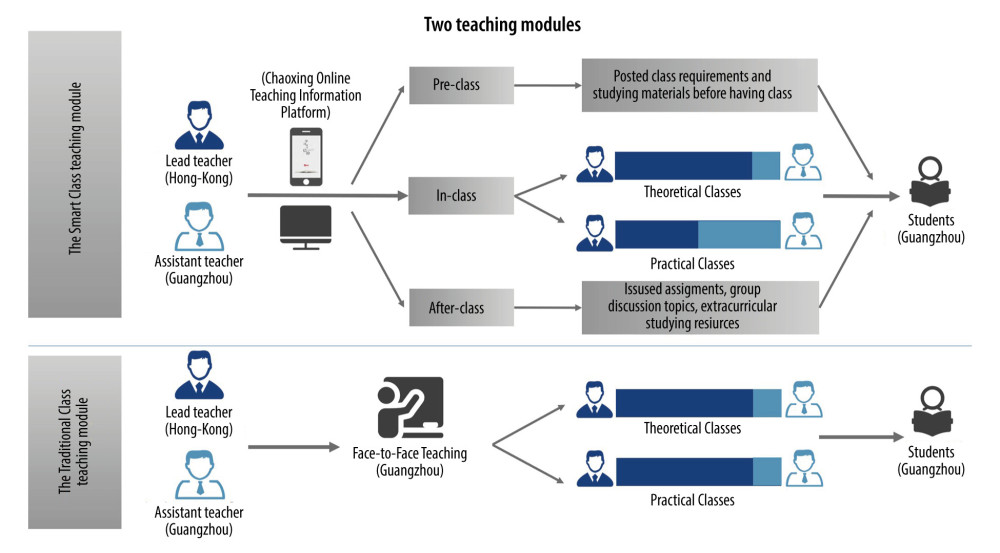 Figure 1. The key elements of the Smart Class teaching module and the Traditional Class teaching module are diagramed.
Figure 1. The key elements of the Smart Class teaching module and the Traditional Class teaching module are diagramed. 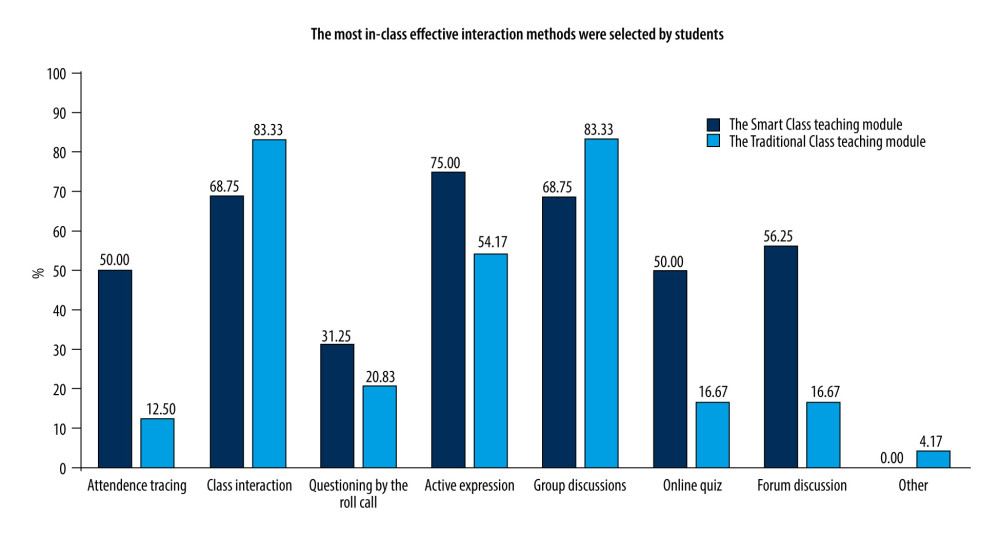 Figure 2. The most effective in-class interaction methods were selected by students. The top 3 student responses in both groups were active expression, class interaction, and group discussion.
Figure 2. The most effective in-class interaction methods were selected by students. The top 3 student responses in both groups were active expression, class interaction, and group discussion. 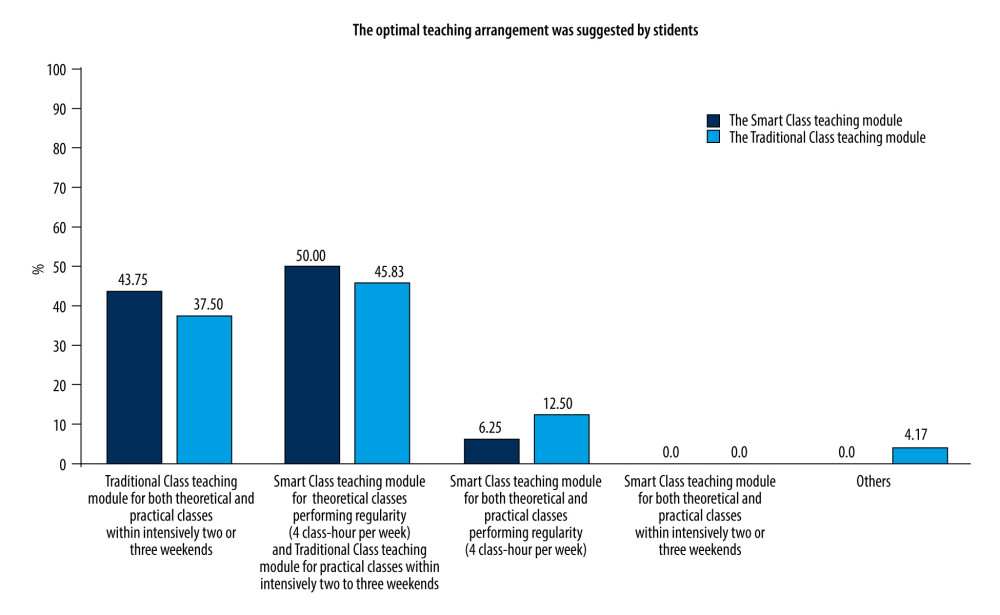 Figure 3. The optimal teaching arrangement was suggested by students. 50% in the Smart Class teaching module group and 45.83% in the Traditional Class teaching module group chose the optimal teaching arrangement of “Take theoretical classes for online teaching, 4 hours per week; take practical classes offline intensively over 2–3 weekends”.
Figure 3. The optimal teaching arrangement was suggested by students. 50% in the Smart Class teaching module group and 45.83% in the Traditional Class teaching module group chose the optimal teaching arrangement of “Take theoretical classes for online teaching, 4 hours per week; take practical classes offline intensively over 2–3 weekends”. References
1. Yan T, Ao LConstruction and development of China’s rehabilitation medicine education system: Chinese Journal of Rehabilitation Medicine, 2019; 34(08); 881-84 [in Chinese]
2. Zhang F, Li H, Cui HProfessional educational experience of rehabilitation therapy in Capital Medical University: Chinese Journal of Rehabilitation Medicine, 2006; 21(04); 286-87 [in Chinese]
3. World Federation of Occupational Therapists: WFOT Approved Education Programme, 2021 https://www.wfot.org/programmes/education/wfot-approved-education-programmes
4. Chen M, Ao L, Jiang FKunming Medical University applies to the World Federation of Occupational Therapists Minimum education standard certification experience: Chinese Journal of Rehabilitation Medicine, 2020; 35(9); 1105-7 [in Chinese]
5. Hu J, Liu X, Zhou QDevelopment and exploration of occupational therapy major construction in Shanghai University of Traditional Chinese Medicine: Zhong Guo Kang Fu, 2015; 30(6); 4374-39 [in Chinese]
6. Yan Y, Yang Y, Lu JInvestigation and analysis of the status quo of occupational therapists in mainland China: Chinese Journal of Rehabilitation Medicine, 2018; 33(7); 833-36 [in Chinese]
7. The Fifth Affiliated Hospital of Guangzhou Medical University: Introduction of Occupational Therapy Major, 2021 https://www.gyfwyy.com/kyjx/ot/a_102721.html
8. QS: QS World University Rankings By Subject 2021 Result Tables, 2021 https://www.qs.com/portfolio-items/qs-world-university-rankings-2021-result-tables-excel/
9. PolyU: Introduction of Department of Rehabilitation Sciences, 2021
10. Lin Q, Qiu Y, Liang J, The Smart Class teaching module for rehabilitation medicine english education in China: Med Sci Monit, 2021; 27; e929834
11. Qin Y, Huang Z, Yu J, Practice-based learning using smart class: a competency-based model in undergraduate radiology education: Acad Radiol, 2020 [Online ahead of print]
12. Raut SJ, Smart Class learning management system for school education: International Journal of Scientific Research in Computer Science and Engineering, 2018; 6(1); 9-13
13. Friedman KA, Herman SW, Fornari A, Medical education using minimal technology: Achieving professional development: Med Educ Online, 2019; 24(1); 1622365
14. Liu FExploration and practice of intelligent classroom teaching mode in polytechnic based on Chaoxing Fanya Platform: Taking the course of computer and big data technology application basis as an example: Journal of Jiyuan Vocational and Technical College, 2020; 19(1); 67-72 [in Chinese]
15. Xing S, A brief discussion on Smart Class teaching module: Times Finance, 2019; 33; 135-36
16. Pei L, Wu H, Does online learning work better than offline learning in undergraduate medical education? A systematic review and meta-analysis: Med Educ Online, 2019; 24(1); 1666538
17. Muilenburg LY, Berge ZL, Student barriers to online learning: A factor analytic study: Distance Education, 2005; 26(1); 29-48
18. Bartley SJ, Evaluating the cost effectiveness of online and face-to-face instruction: J Educ Technol Soc, 2004; 7(4); 167-75
19. Mauer RE, Multimedia learning: Psychol Learn Motiv, 2002; 41(1); 85-139
20. Rajab MH, Gazal AM, Alkattan K, Challenges to online medical education during the COVID-19 pandemic: Cureus, 2020; 12(7); e8966
21. Boynton PM, Greenhalgh T, Selecting, designing, and developing your questionnaire: BMJ (Clinical research ed), 2004; 328(7451); 1312-15
22. Trakman GL, Forsyth A, Hoye R, Belski R, Developing and validating a nutrition knowledge questionnaire: Key methods and considerations: Public Health Nutr, 2017; 20(15); 2670-79
23. Streiner DL, Starting at the beginning: An introduction to coefficient alpha and internal consistency: J Pers Assess, 2003; 80(1); 99-103
24. Bowling A, The psychometric properties of the older people’s Quality of Life Questionnaire, Compared with the CASP-19 and the WHOQOL-OLD: Curr Gerontol Geriatr Res, 2009; 2009; 298950
25. Kallio H, Pietilä AM, Johnson M, Kangasniemi M, Systematic methodological review: Developing a framework for a qualitative semi-structured interview guide: J Adv Nurs, 2016; 72(12); 2954-65
26. Maloney S, Moss A, Keating J, Sharing teaching and learning resources: Perceptions of a university’s faculty members: Med Educ, 2013; 47(8); 811-19
27. Kuhlmann T, Dantlgraber M, Reips UD, Investigating measurement equivalence of visual analogue scales and Likert-type scales in Internet-based personality questionnaires: Behav Res Methods, 2017; 49(6); 2173-81
28. Mircioiu C, Atkinson J, A comparison of parametric and non-parametric methods applied to a Likert Scale: Pharmacy (Basel, Switzerland), 2017; 5(2); 5020026
29. Liu BResearch on design and implementation strategy of Smart Class teaching in the era of “Internet +”: China Audio-Visual Education, 2016; 10; 51-56 [in Chinese]
30. Prunuske AJ, Batzli J, Howell E, Miller S, Using online lectures to make time for active learning: Genetics, 2012; 192(1); 67-72 quiz 61Sl–63SL
31. Khalil R, Mansour AE, Fadda WA, The sudden transition to synchronized online learning during the COVID-19 pandemic in Saudi Arabia: A qualitative study exploring medical students’ perspectives: BMC Med Educ, 2020; 20(1); 285
32. Nepal S, Atreya A, Menezes RG, Joshi RR, Students’ perspective on online medical education amidst the COVID-19 pandemic in Nepal: J Nepal Health Res Counc, 2020; 18(3); 551-55
33. Mukhtar K, Javed K, Arooj M, Sethi A, Advantages, limitations and recommendations for online learning during COVID-19 pandemic era: Pak J Med Sci, 2020; 36(Covid19-S4); S27-31
34. Grzych G, Schraen-Maschke S, Interactive pedagogical tools could be helpful for medical education continuity during COVID-19 outbreak: Ann Biol Clin (Paris), 2020; 78(4); 446-48
35. Wang C, Xie A, Wang W, Wu H, Association between medical students’ prior experiences and perceptions of formal online education developed in response to COVID-19: A cross-sectional study in China: BMJ Open, 2020; 10(10); e041886
Figures
 Figure 1. The key elements of the Smart Class teaching module and the Traditional Class teaching module are diagramed.
Figure 1. The key elements of the Smart Class teaching module and the Traditional Class teaching module are diagramed. Figure 2. The most effective in-class interaction methods were selected by students. The top 3 student responses in both groups were active expression, class interaction, and group discussion.
Figure 2. The most effective in-class interaction methods were selected by students. The top 3 student responses in both groups were active expression, class interaction, and group discussion. Figure 3. The optimal teaching arrangement was suggested by students. 50% in the Smart Class teaching module group and 45.83% in the Traditional Class teaching module group chose the optimal teaching arrangement of “Take theoretical classes for online teaching, 4 hours per week; take practical classes offline intensively over 2–3 weekends”.
Figure 3. The optimal teaching arrangement was suggested by students. 50% in the Smart Class teaching module group and 45.83% in the Traditional Class teaching module group chose the optimal teaching arrangement of “Take theoretical classes for online teaching, 4 hours per week; take practical classes offline intensively over 2–3 weekends”. Tables
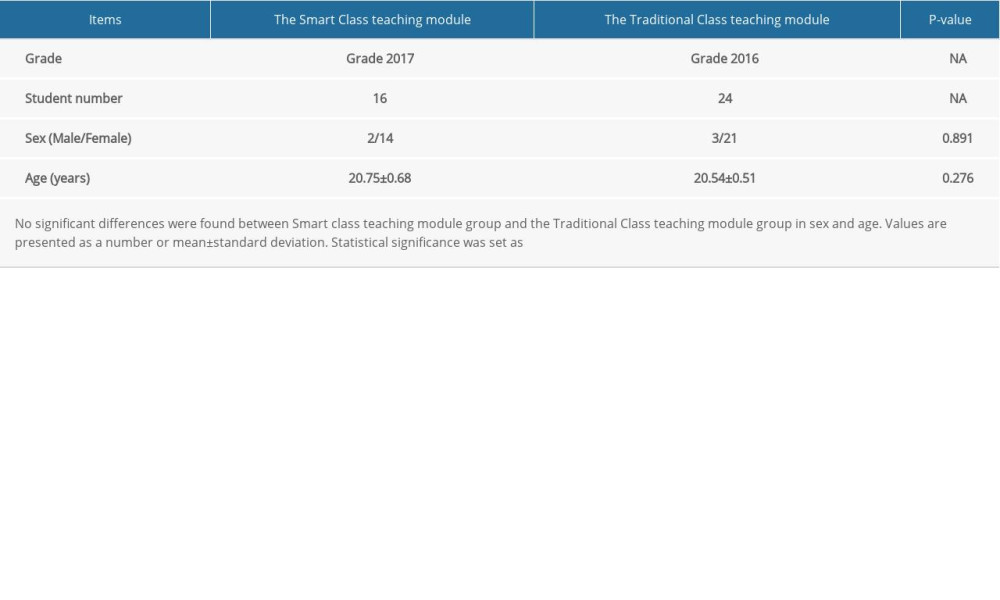 Table 1. Basic characteristics of OT students in the 2 different teaching modules.
Table 1. Basic characteristics of OT students in the 2 different teaching modules.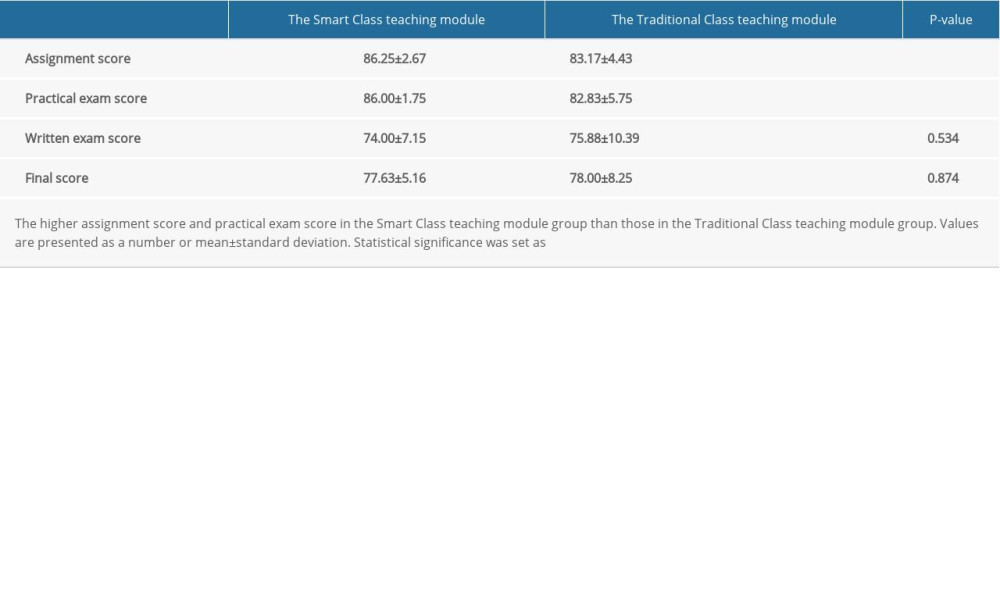 Table 2. The differences in course scores between the 2 types of teaching modules.
Table 2. The differences in course scores between the 2 types of teaching modules.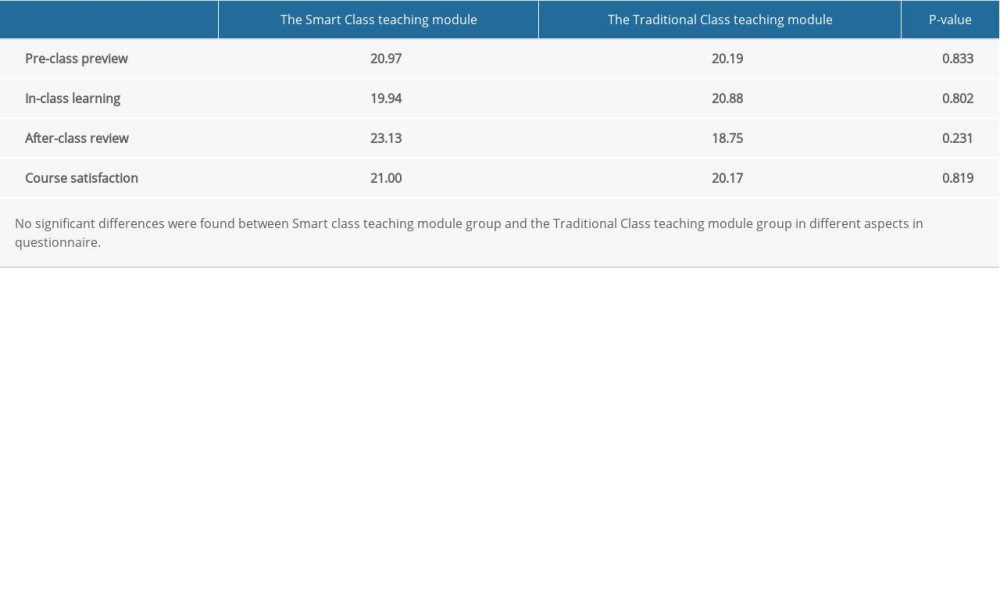 Table 3. The results of the questionnaire between the 2 types of teaching modules.
Table 3. The results of the questionnaire between the 2 types of teaching modules. Table 1. Basic characteristics of OT students in the 2 different teaching modules.
Table 1. Basic characteristics of OT students in the 2 different teaching modules. Table 2. The differences in course scores between the 2 types of teaching modules.
Table 2. The differences in course scores between the 2 types of teaching modules. Table 3. The results of the questionnaire between the 2 types of teaching modules.
Table 3. The results of the questionnaire between the 2 types of teaching modules. In Press
07 Mar 2024 : Clinical Research
Knowledge of and Attitudes Toward Clinical Trials: A Questionnaire-Based Study of 179 Male Third- and Fourt...Med Sci Monit In Press; DOI: 10.12659/MSM.943468
08 Mar 2024 : Animal Research
Modification of Experimental Model of Necrotizing Enterocolitis (NEC) in Rat Pups by Single Exposure to Hyp...Med Sci Monit In Press; DOI: 10.12659/MSM.943443
18 Apr 2024 : Clinical Research
Comparative Analysis of Open and Closed Sphincterotomy for the Treatment of Chronic Anal Fissure: Safety an...Med Sci Monit In Press; DOI: 10.12659/MSM.944127
08 Mar 2024 : Laboratory Research
Evaluation of Retentive Strength of 50 Endodontically-Treated Single-Rooted Mandibular Second Premolars Res...Med Sci Monit In Press; DOI: 10.12659/MSM.944110
Most Viewed Current Articles
17 Jan 2024 : Review article
Vaccination Guidelines for Pregnant Women: Addressing COVID-19 and the Omicron VariantDOI :10.12659/MSM.942799
Med Sci Monit 2024; 30:e942799
14 Dec 2022 : Clinical Research
Prevalence and Variability of Allergen-Specific Immunoglobulin E in Patients with Elevated Tryptase LevelsDOI :10.12659/MSM.937990
Med Sci Monit 2022; 28:e937990
16 May 2023 : Clinical Research
Electrophysiological Testing for an Auditory Processing Disorder and Reading Performance in 54 School Stude...DOI :10.12659/MSM.940387
Med Sci Monit 2023; 29:e940387
01 Jan 2022 : Editorial
Editorial: Current Status of Oral Antiviral Drug Treatments for SARS-CoV-2 Infection in Non-Hospitalized Pa...DOI :10.12659/MSM.935952
Med Sci Monit 2022; 28:e935952








